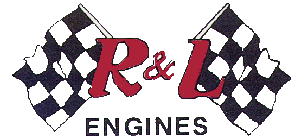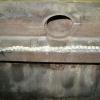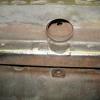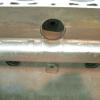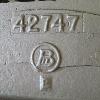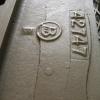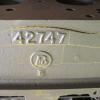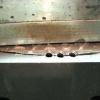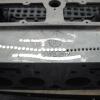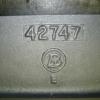(603)-742-8812
Established In 1981
Engine Block & Cylinder Head Crack Repair
MGTD Water Jacket Crack Repair
Click on images for descriptions
Many different concepts have been tried over the years and most have been called metal stitch or metalock. A main part of the process that replaces the crack itself is the stitching pins. Some of the items that have been and are still used are: bolts (copper-and zinc-plated); tapered plugs (both threaded and non-threaded); threaded rods; screws; set screws; dowels; and just about anything else that could be stuffed, hammered or screwed into the space. Over time, these items have been called 'plugs', 'pins' and 'stitching pins'. Modern CNC machining processes have made it possible to manufacture new patented thread and design technologies that have made very important improvements to the art of casting repair.
The other element of metal stitching or metalocking is the locks. They are primarily used in industrial repairs although there are applications in smaller castings. Locks require a flat spot for installation. Locks have also evolved over the years and have been created in many shapes, sizes and strengths. LNS has a wide range of locks for performing repairs. Our receiving hole patters are completely created by drilling unlike the old Metalock process that relies on drilling spaced out holes and then using crude chiseling procedures to connect the holes. This lack of precision and size limitation leaves the old process seriously lacking in strength and function.
Many repairs may require using only stitching pins such as in cracked cylinder head repairs and cracked engine block repairs. Often large industrial repairs with structural damage only that don't require sealing the crack can be repaired with Locks only
Metal stitching or metalocking as it is called in some parts of the world, have become generic phrases that describe methods of repairing cracks in cast metals without welding. Why metal stitching? Well, primarily because of the need for an alternative to the difficulties encountered in welding. Cast iron is the most difficult of all common cast metals to weld. All electric welding methods for cast iron have proven to be less than satisfactory and in many cases can cause even more cracks. Most electric welds with nickel rod on cast iron fail. Most cause more damage than was present before the attempted weld. Proper cast iron welding techniques require complete disassembly and oven preheat at 900º F. to 1500° F. And there is a lot of time and effort involved in the clean-up and machine work of any welded piece.
Cast Iron Engine Block & Cylinder Head Crack Repair
Pre-War Triumph Crack Repair
Click on images for descriptions
There are over 30 different stitching pins, which come in several diameters and thread lengths. These special stitching pins are used daily by hundreds of repair technicians around the world to perform engine block crack repairs and cylinder head crack repairs. Sealing leaks and re-creating strength is very cost effective and reliable.
There 8 different lock sizes available. No matter what your application, from a small automotive block to a large extrusion press, there is a lock to suit your needs. When you need to recreate structural strength and integrity, Lock-N-Stitch™ locks will get the job done. The Lock-N-Stitch™ lock design can pull the crack together and create the highest possible amount of strength in the repair. Rather than making a hole pattern by chiseling like the method used in the old metal locking process, we utilize a high precision drill fixture to make the hole pattern completely by drilling, to receive the locks in order to assure the best and strongest possible repair.
Speed. Installing LNS products can be done quickly with pneumatic tools. Up to one inch of repair can be done in 5 minutes in 1/4" thick cast iron.
Ease of use. The pins are designed with a breakoff groove that causes each pin to break off at the same predetermined torque.
Flawless finish. All LNS pins have shoulders that set into the casting so the threads aren't exposed at the surface. Perfect metal-to-metal finishes are easy to accomplish.
High pressure seal. Stress free, uniform repairs seal without the use of epoxies and coatings required by inferior stitching products.
Holding power. LNS pins and locks create strength and seal over every linear inch of the repair.
Complex contours. Inside and outside corners are now as easy as flat surfaces. C Series (CASTMASTER™) stitching pins don't spread the crack, in fact they pull the sides of the crack together.

